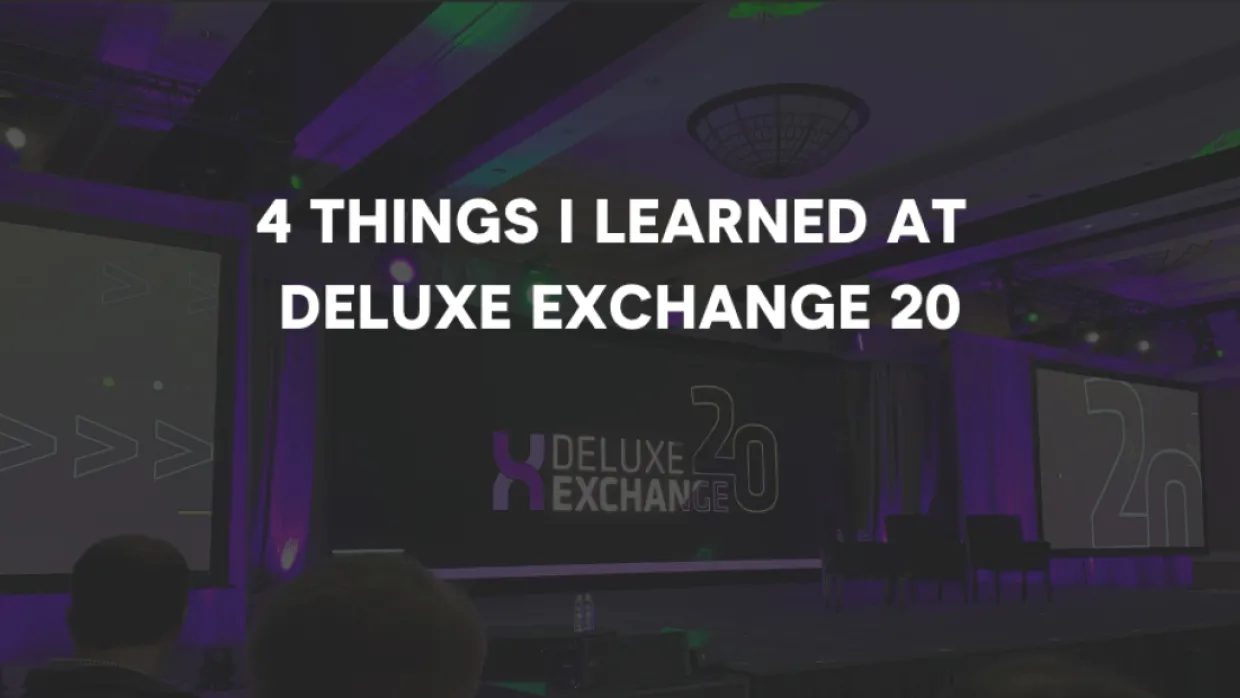Digital strategy
Top 4 takeaways from Deluxe Exchange 20

Last month, I flew to Phoenix, Arizona for Deluxe Exchange 20—a two-day conference for business leaders centered around market growth and digital transformation. At this event, I had the chance to meet tons of talented industry experts and attend quite a few insightful speaker sessions ranging from inspirational anecdotes to technical tutorials. Here are the four biggest lessons I took away from this event.
Takeaway 1: I don’t want to be a camper.
Erik Weihenmayer is the first blind person to reach the summit of Mt. Everest. During Erik’s inspirational speaker session at Deluxe Exchange 20, he discussed the incredible amount of preparation and training he underwent to climb the world’s tallest peak. Erik explained that there are three main types of travelers on an expedition: Quitters, Campers and Climbers.
Quitters are self-explanatory—they easily give up. Campers aspire to reach the pinnacle, but at some point they get complacent and decide to set up their tents. FInally, Climbers are driven to complete their journey no matter what. An interesting note about climbing Mt. Everest: It only counts if you make it back down. This means the summit is only the half-way point!
My takeaway: Don’t set up camp. This session was a motivating reminder to embrace the Climber mentality by encouraging myself and those around me to always keep going.
Takeaway 2: Divide and conquer is the best approach to predictive modeling.
On the more technical side of things, I checked out Data Scientist Eugene Geis’ crash course on predictive modeling. Eugene illustrated how predictive modeling works—we went over detailed algorithms and discussed different approaches and models depending on the situation. For instance, seeing Eugene’s image recognition and data mining example demonstrated how three simple, specific pixels can drive high accuracy.
My takeaway: It’s all about divide and conquer. You start with large data sets and recursively break them down into two or more sub-problems until they become simple enough to solve. From what I learned, five is the magic number.
Challenges can seem insurmountable. But instead of trying to solve a large, unwieldy problem all at once, I encourage my clients and peers to start by tackling smaller, focused challenges. As you break down data into more manageable chunks and identify solutions for each one, be careful not to overcomplicate outcomes.
Takeaway 3: Apply the right solution to the right problem.
Many sessions had a unique take on payment processing. Each expert had a different answer to solve the challenges surrounding the payment process industry’s information, security, processes and evaluation. But ultimately, it comes down to the root issue. Instead of throwing limited resources at a band-aid fix, businesses need to analyze the actual issue to identify the right solution. For example, if you have a problem with a certain technology, the root cause could be connected to your business process and organizational change readiness.
Many organizations are eager to jump into marketing automation via Salesforce Marketing Cloud. In my experience, they’re often planning to automate their communications to reduce the human hours needed to send campaigns. But as they begin to describe their vision of marketing nirvana to us, we find out that their data isn’t set up to power their desired automation. For this reason, we use a multi-phase approach to get a better handle on the data and learn which fidelity of automations is good to go.
Takeaway 4: All businesses (even small ones) need digital transformation.
According to Small Business Revolution, small towns and businesses need to leverage technology to stay visible and deliver the best experiences to their customers and employees. In today’s experience economy, an outstanding customer experience is your biggest customer advantage. A recent survey by Forbes found:
- 96% of consumers choose brands based on CX.
- 84% of CX-focused brands yield greater year-one revenue.
- CX-centric brands are 60% more profitable.
Your business is only as good as your worst customer experience. That’s our call to arms at Horizontal Digital. Here’s a key stat:
“67% of customers switch brands – not due to price or features – but due to customer experience or a perceived lack of attention, personalization, and engagement by the brand.” — US Chamber of Commerce
Looking for an experience-forward approach to your customer experience strategy? Let’s talk. Since 2004, Horizontal Digital has helped clients unlock the possibilities of marketing and technology.